Stewart Jones, a keen garlic grower from Mansfield Woodhouse in Nottinghamshire, shares how he grows his garlic crop on his plot on the Kingsley Allotment site.
Varieties
He only grows softneck garlic varieties because of their better keeping qualities along with some Elephant Garlic. He’s currently growing 200 garlic plants made up from: Vallelado, Provence White, Iberian and Early Purple White along with 24 plants of Elephant Garlic.
Seed Saving Garlic
He retains the best of each years crop to provide the seed for the following season. He says
In the last 5 years I have only replaced the odd variety and only if my own crop has started to diminish in size and quality.
Cultivation
Allium Leaf Miner
The site has for some years been plagued with Allium Leaf Miner which attacks garlic just as much as onions hence he grows garlic under protective netting. He supports the net with canes on each side and completely weighs it down with bricks on either side. He does this as the construction has to withstand the winter winds and snow. If there is heavy snow he will remove as much as possible to lighten the pressure on the net.
Growing under netting will also moderate harsh weather, reducing wind speed which will reduce wind chill.
Planting
Stewart retains the best of the current years crop to set again the very last week in October. Usually he follows the potatoes which will have been manured and the soil well cultivated.
Because he’s growing under netting, he leaves a space between rows to crawl down and cultivate the crop and to plant out his Longor Shallots (usually 1st April) under the net.
Crop Care
He keeps the crop weed free and feeds with a handful of sulphate of potash around each 3 of 4 plants which is raked into the soil with a hand rake when he plants out shallots on 1st April. Remember, he has to use a hand tool as he’s crawling under the netting.
The netting remains on until May when it’s taken off to be used on the Brussels sprouts. Stewart feels the netting also helps to protect the garlic against rust although he inevitably has to spray for rust once the net is off, depending on the climate conditions at the time.
Watering
Stewart makes the point that keeping the crop watered is important. He’s located in a dryer area of the country, east of the Pennines. He gets less than 700 mm per annum of rain. For comparison, here in North Wales we get around 1150 mm per annum of rain.
He stops watering around mid-June, roughly a month before harvesting the crop in mid-July.
Finally he says
Although my wife, friends and family use a terrific amount of garlic I intend to reduce October 2019 settings by one or maybe two rows as I am trying my best to grow show onions and although I have a similar net for my maincrop of onions I need the extra space.
I suspect someone is going to have a few red (winner) cards at the shows next year!

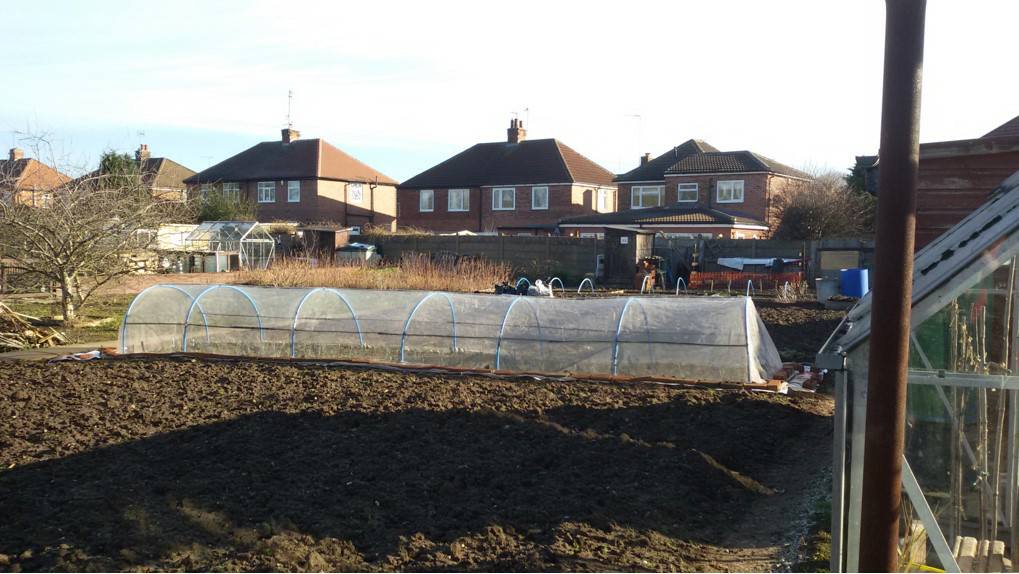
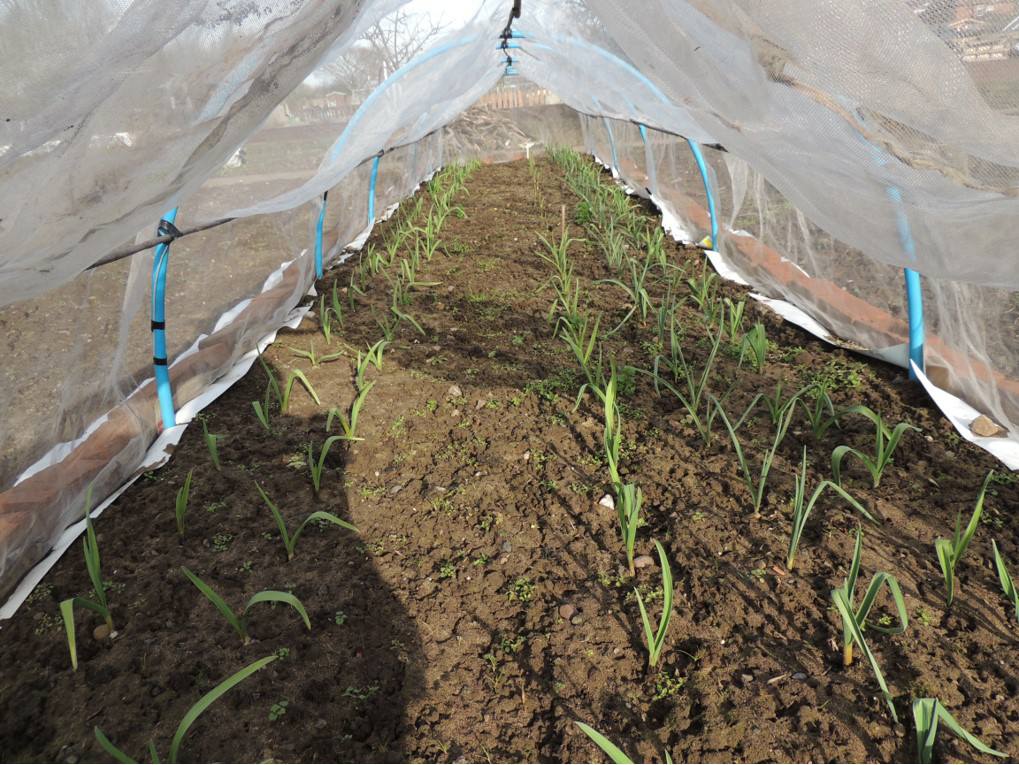
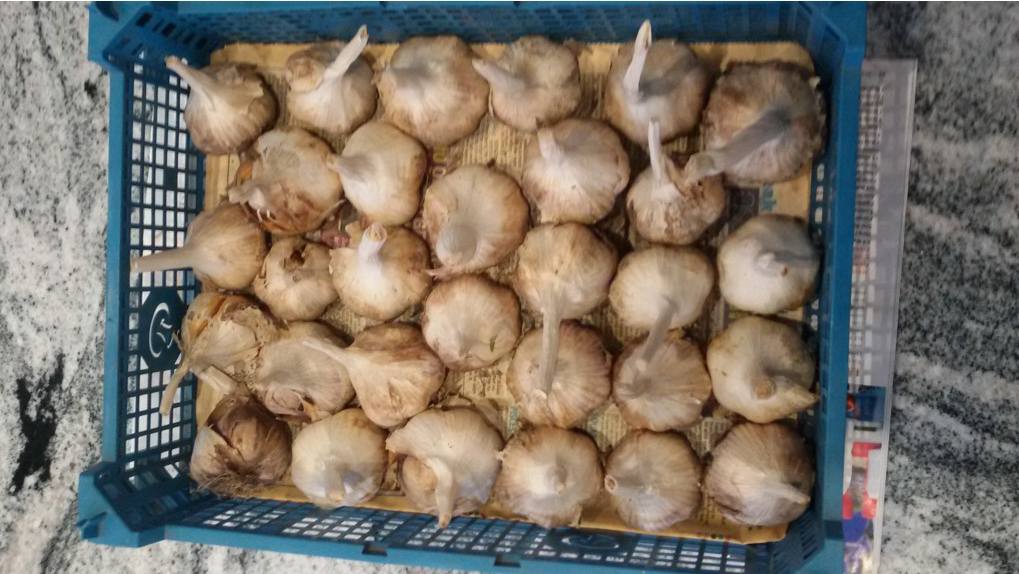

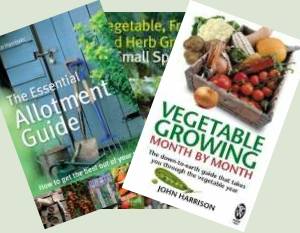
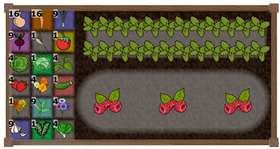
What does he use as a spray for rust please?
Didn’t say – but there are a number of anti-fungal sprays available although not approved for food crops. A traditional remedy is to dust with flowers of sulphur
My garlic last year,was reasonable in size, I dried it off as previous years, tied it strings and hung it in my garage, it has not kept nearly every clove is sprouting, what have I done wrong? I live in South Warwickshire and have an allotment. Advice please Guys!
If the garage was too cold, the garlic sprout in response to the chill. I keep mine indoors and it doesn’t sprout until spring
Do you know of anyone who has tried inserting a piece of copper wire, through the garlic stem, to prevent rust and if so was it was successful?
I read about it in some literature from The Garlic Farm in the Isle of Wight. However, I cannot find information about it being used.
That’s interesting – copper based fungicides like Bordeaux mixture are effective but I’ve not heard of copper wire. Perhaps someone could do a trial.
Bordeaux mixture is one of those EU can’t have things now! Thankfully it can be easily home made. Copper sulfate and Magnesium or potassium bicarbonate are the two components. I prefer the potash bicarb because it is also good with cucumbers for the fungus that occasionally gets their leaves (US sites have details). Take care when mixing as one is mild acid and ‘tother is alkali; roughly mixed they make a lot of bubbles! Suppliers of chemicals (very cheap) and details are readily available on the net.
I’m building a new web site about the dig for victory campaign – one of the leaflets was How to Make Bordeaux & Burgundy Mixtures
Another “you can’t have/buy” is Cheshunt Compound for preventing seedlings damping off. Luckily being a retired industrial chemist, I have the two ingredients Copper Sulphate and Ammonium Carbonate. I’d be happy to share more details for your new website.
If it’s a ‘EU can’t have now’ thing there will be a good reason for it.
Lovely article on garlic growing, I grow mine in a polytunnel, as I live in Ireland watering is not usually an issue. By the way I was born in Mansfield Woodhouse and moved to Ireland from there, so I know Stewart’s area very well. I also keep my garlic for sowing the following year and it is fun to try different varieties.
I really must get on the Holyhead ferry and pay a visit – we can just see Ireland at sunset in the Autumn 🙂
Had a good crop of garlic, last years planting, and coming up well. However I’ve noticed rust on it, something the other allotment growers don’t seem to have. Is it a viral infection, or indicative of a mineral deficiency in the soil? Last year I added well rotted manure, and limed it in the autumn
Rust is a fungal disease.
Yeah, meant to say fungal, but that last post was put on very late at night after a 15 hour shift. Anyway, my garlic recovered dramatically after a good watering and had my best crop ever. Also noticed that i had leaf curl on my pear tree, internet says drought is the most likely cause, as I’ve found no aphids. So it seems to tie in with what Stewart was saying
I’ve been growing Garlic for many years successfully, i once got rust and was told by an old hand on the allotment’s that if you grow too many to close together this can encourage rust so after that advise I’ve always planted at least 3 feet apart and i have to say I’ve need had rust since.
The main article makes reference to “garlic seeds”. Presumably these are cloves and not the clones that can sometimes grow rather as do the seeds on onions?
The mention of frequent & good watering by several users is very interesting. Most books and a lot of on line articles advise to leave alone unless they are near desperately dry. Further to earlier commentary on fungus etc. All my garlic types were looking distinctly sad toward the end of the recent long dry spell. Many had wilting yellow leaves & I was thinking they must be ready very early. To my amazement, they are all (apart from the dead bits) spritely and green since the recent downpours. Another lesson learned.
when does he plant these garlic cloves ?
Some varieties of garlic are planted in autumn, some in spring. Check recommended sowing period when choosing what to grow.
I too live in North Wales. I always plant my garlic cloves in February as I feel the soil here is so cold and wet in midwinter there is no advantage in planting before Christmas. It seems to work as so far both cropping and storage have been excellent.
Regarding rust on aliums, I really had problems in Lincolnshire; if possible, see if you can source some ‘Opal’ fungicide it is food-safe and gives treatment-to-harvest times on the label. Opal is expensive, it comes in litre bottles only though, but any amenity web sites sell it.
Bordeaux mixture:
I’ve making this for years
Ingredients:
16 grams copper sulphate
10 grams garden lime
1 litre water
I mix it all together in an old (cleaned) plastic milk bottle, give it a good shake, then pass it through some old net curtain to get rid of the big lumps. Spray when the temperature and humidity reaches that magic number (Hutton Criteria).
Actually I normally make up a 5x concentrate (enough for the season) in a milk bottle with 5 graduation marks on the outside so when required I pour 1/5 (20%) into my sprayer and top it up with 1 litre of water. I know it works because I am the only allotmenteer on our allotment who never suffers from blight or rust. Hope this helps
Thanks for the recipe Norman. I grow garlic every year and have had great harvests but our allotment suffers from rust.
I live in the north east & have never had rust problems (lucky maybe) but I always plant Autumn garlic/onions (in a raised bed) manured for potatoes the year before & give a high nitrogen fertilizer in early spring + I top-dress the beds with an inch or two of home made compost. Keeping qualities are never a problem (again, might be just lucky) as I still have perfect onions now in April from a July/August harvest. Hope folks find this helpful!
I have really disappointing garlic, my first attempt was great but never since. They are sown in raised beds in rotation Pots, Peas, Brassicas, leeks and roots – they are sown generally after brassicas as this would be the roots and onion bed for the following year. Is this the wrong place, others here seem to say after potatoes! They mostly all shoot sown autumn, under net, then die off leaving many gaps, they don’t bulk up and are a bit rubbish for keeping! I sow softneck varieties as I want them to store but sometimes I wonder why I bother!! Any helpful advise?
Same problem here. We’re in Warwickshire. Started growing Garlic (and onions) around 8 years ago. First season or two great. Then gradually worse as time went on. Last two seasons we’ve had white rot. I moved the stuff round each year, but no improvement. Trying again this year – but not with garlic.